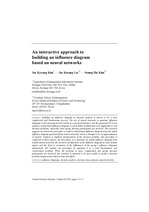

-
미리보기
목차
ABSTRACT
1. Introduction
2. Influence diagram
3. Decision class analysis and neural network
4. Neural network based process to build an ID
5. Interactive procedure to build an ID
6. An illustrative case example
7. Conclusions
8. References본문내용
Building an Influence diagram in decision analysis is known to be a most complicated and burdensome process. The use of neural networks to generate influence diagrams in the topological level results in a good performance, the generated ID is usually not a well-formed influence diagram. Furthermore it needs more modification to be applicable to real decision problems, especially when group decision participants are involved.
This research suggests an interactive procedure to build a well-formed influence diagram from the initial influence diagram generated from neural networks which are thought to be an approximation of experts’ (explicit or implicit) interpretation of decision problem. Our procedure is composed of two phases; one is to modify the influence diagram by each decision participant, the other one is to resolve the differences of group’s influence diagram interactively. We applied our procedure to an analogous land development and conservation problems. When the problem is complicated and group decision participants are involved, this research is expected to be more useful to inexpensively model a decision problem.참고자료
· [BUN 84] BUNN D.W., Applied Decision Analysis, McGraw-Hill, New York, 1984.
· [CHU 92] CHUNG T.Y., KIM J.K., KIM S.H., Building an influence diagram in a know-
· ledge based decision system, Expert Systems With Applications, vol. 4, 1992, p. 33-44.
· [HOL 89] HOLTZMAN S., Intelligent Decision Systems, Addison-Wesley, MA, 1989.
· [HOW 84] HOWARD R.A., The used car buyer, in Readings on the Principles and
· Applications of Decision Analysis. Vol. II, ed. R.A. Howard and J.E. Matheson, Strategic
· Decision Group, Menlo Park, CA, 1984.
· [HOW 88] HOWARD R.A., Decision analysis: practice and promise, Management Science,
· vol. 34, 1988, p. 679-695.
· [KIM 91] KIM J.K., A Knowledge-Based System for Decision Analysis, Ph.D. thesis,
· Department of Industrial Engineering, KAIST, Korea, 1991.
· [KIM 92] KIM J.K., CHUNG T.Y., KIM S.H., A knowledge-based decision system to build
· an influence diagram: KIDS, Proceedings of the First World Congres on Expert
· Systems, Orlando, Florida, 1992.
· [KIM 95] KIM J.K., A Study on the Development of Intelligent Decision Systems Using
· Influence Diagram, Journal of the Korean OR/MS Society, vol. 20, 1995, p. 77-104.
· [KIM 97] KIM J.K., PARK K.S., Neural network-based decision clas analysis for building
· topological-level influence diagram, International Journal of Human-Computer Studies,
· vol. 46, 1997.
· [KIM 98] KIM J.K., CHU, S.C., Sensitivity Analysis in the Decision Class Analysis Using
· Neural Networks, Proceedings of the Fourth World Congres on Expert Systems,
· Mexico, 1998.
· [OLM 84] OLMSTED, S.M., On Representing and Solving Decision Problems, Ph.D.
· thesis, Department of Engineering-Economic Systems, Stanford University, 1984.
· [REE 89] REED, J., Building decision models that modify decision systems, Knowledge
· System Laboratory, no. KSL-89-21, Stanford University, Stanford, CA, 1989.
· [RUM 86] RUMELHART D., MCLELLAND J., Parallel Distributed Processing, vol. 1.
· MIT Pres, Cambridge, Mas., 1986.
· [SHA 86] SHACHTER R.D., Evaluating influence diagrams, Operations Research, vol. 34,
· 1986, p. 871-882.
· An influence diagram based on neural networks 17
· [SHA 88] SHACHTER R.D., Probabilistic inference and influence diagrams, Operations
· Research, vol. 36, 1988, p. 589-604.
· [SON 94] SHONNENBER F.A. et al., An Architecture for Knowledge-based Construction
· of Decision Models, Medical Decision Making, vol. 14, 1994, p. 27-39.
· [VOL 88] VOLKEMA R., Problem Complexity and the Formulation Proces in Planning
· and Design, Behavioral Science, vol. 33, 1988, p. 292-300.
· [WOO 81] WOOLLEY R., PIDD M., Problem Structuring A Literature Review, Journal
· of Operational Research Society, vol. 32, 1981, p. 25-63.
· [ZAH 91] ZAHEDI F., An introduction to neural networks and a comparison with artificial
· intelligence and expert systems, Interfaces, vol. 21, 1991, p. 25-38.태그
-
자료후기
Ai 리뷰지식판매자의 해당 자료는 과제를 작성하는 데 큰 도움이 되었고, 내용이 풍부하여 많은 정보를 얻을 수 있었습니다. 정말 추천할 만한 자료입니다. -
자주묻는질문의 답변을 확인해 주세요

꼭 알아주세요
-
자료의 정보 및 내용의 진실성에 대하여 해피캠퍼스는 보증하지 않으며, 해당 정보 및 게시물 저작권과 기타 법적 책임은 자료 등록자에게 있습니다.
자료 및 게시물 내용의 불법적 이용, 무단 전재∙배포는 금지되어 있습니다.
저작권침해, 명예훼손 등 분쟁 요소 발견 시 고객센터의 저작권침해 신고센터를 이용해 주시기 바랍니다. -
해피캠퍼스는 구매자와 판매자 모두가 만족하는 서비스가 되도록 노력하고 있으며, 아래의 4가지 자료환불 조건을 꼭 확인해주시기 바랍니다.
파일오류 중복자료 저작권 없음 설명과 실제 내용 불일치 파일의 다운로드가 제대로 되지 않거나 파일형식에 맞는 프로그램으로 정상 작동하지 않는 경우 다른 자료와 70% 이상 내용이 일치하는 경우 (중복임을 확인할 수 있는 근거 필요함) 인터넷의 다른 사이트, 연구기관, 학교, 서적 등의 자료를 도용한 경우 자료의 설명과 실제 자료의 내용이 일치하지 않는 경우
문서 초안을 생성해주는 EasyAI

